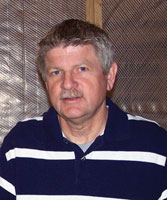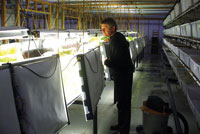
Larry Forrest, principal, Grow Anywhere LLC, Frederick, CO. Source: Grow Anywhere LLC.
Aeroponic cultivation was virgin territory in the early 1980s when Richard Stoner, a woodworker and clock maker, became involved with it. He was issued one of the earliest patents related to aeroponic methodology, having developed an enclosed chamber in which plant cuttings were suspended and nurtured with an intermittent mist. His first company, Genesis Technology Inc., jumped into the fresh-cut produce business, growing basil, lettuce and other vegetables for sale in Colorado supermarkets. The venture eventually failed, but the system’s potential caught the attention of Weyerhaeuser Co., which contracted with Stoner to root pine seedlings. His apparatus’ superiority to in vitro tissue cultures also led to collaborations with NASA-funded firms. One was Bio Serve Space Technologies, where a chemical engineering professor at Colorado State University was researching the microbiology of shells. They partnered to create Organic Disease Control (ODC), a natural liquid biocontrol that accelerates development of plants’ immune systems and boosts growth.
While much of Agrihouse’s efforts were focused on outer space, one of its investors felt earth-bound development needed more attention. In 2005, Larry Forrest, a Boulder, CO optometrist, launched Grow Anywhere LLC. Forrest acquired warehouse space and began growing microgreens for chefs at upscale Denver restaurants. With the kinks worked out and distribution deals bringing Grow Anywhere close to profitability, Forrest is preparing to take the system to the next level, either franchising the concept or raising capital to build facilities in as many as 50 locations

Grow lights are needed, but water use is minimal in an aeroponics warehouse. Grow Anywhere managers are making the business case for commercial crops grown in the air. Source: Grow Anywhere LLC.
Forrest: When the price of oil crashed in the 1980s, the operation no longer was viable. Additionally, ODC wasn’t available then, and even though there was sunshine 340 days a year, the other 25 days were killing the greenhouse. Spores in the air immediately start spreading mold in the dark.
Mold is just as big a problem in the space program. There are very few pesticides that can be used in a greenhouse or a space capsule, and controlling the mold in the air is a challenge in both environments. That’s why NASA helped fund development of ODC.
FE: The misting process is called hydro atomization. Please describe.
Forrest: The water and nutrients build up to 100 psi, then pressure is released as they go through the hydro-atomizing jet. There is a little plate at the front of the misting orifice that fractionates each water droplet to a size of 5-50 microns.
FE: Are there maintenance issues with the nutrients clogging the jets?
Forrest: In the 1980s, we relied on a brass jet with a steel impingement arm that came over the orifice. Because you had two dissimilar metals, and because a current runs through the water, there was calcification and mineral buildup. With the help of one of our NASA grants, we were able to design a nylon nozzle that resolves the issue.
FE: How are plants supported?
Forrest: The original system was modified in partnership with Bio Serve Space Technologies with the second NASA grant. It looks like an inverted volcano, with very smooth surfaces on the inside. Separating the top of the plant from the roots is a microfilm with very low mass. The roots grow through the proprietary film, which essentially supports the plant.
FE: What types of produce are you growing?
Forrest: Cilantro, arugula, onions, beets, corn and pea sprouts-it’s truly garnish for restaurants. Everything is sold in a 2-oz. box for about $8, and each box might complement 20 plates. Restaurants that charge $16 or more per serving usually rely on Mexican suppliers who are three days away from them for these ingredients. Our microgreens are hours old when they arrive at Colorado restaurants, and they’re healthier and tastier.
FE: How does aeroponics compare with hydroponics?
Forrest: The water and nutrients required are significantly less with aeroponics. In the low-gravity tests on the space station, aeroponics required 65% less water and 45% less nutrient inputs than hydroponics while increasing the amount of biomass by 80%. Instead of immersing the plant’s roots in water, they are exposed to the oxygen they need all of the time, except for the three seconds of misting that occurs every 30-40 minutes.
Hydroponics is used extensively for tomatoes, but it hasn’t been particularly successful for other crops, partly because it is energy- and water-intensive. Aeroponics is radically different because it uses a fraction of the water and energy. Our plants are hanging in the air, not sitting in water. We only use a few gallons of water and solution a day. It’s something like the misting systems in supermarkets’ produce sections. The biggest expense is artificial lighting, which costs $800-$900 a month.
FE: How large a yield do you get?
Forrest: We generate 250-300 2-oz. containers a week in a growing area that’s 1,800 sq. ft. We use scissors to harvest the crop, which sounds labor intensive but probably is less so than in conventional operations, where microgreens have to be washed and dried before shipping. These are delicate crops, and gentle handling is critical. With aeroponics, a couple of people can harvest 100 boxes in about three hours.
From seed to sale, the plants take two weeks to mature. They grow faster, are more robust and weigh more thanks to ODC. We don’t have any problems with pests, even though we don’t use any pesticides.
FE: What challenges have you faced with the greenhouse?
Forrest: We killed a lot of plants the first year due to interruptions in the misting. If the lights are on and the water isn’t flowing, you can cook the plants in a couple of hours.
An unexpected problem early on was the alkalinity of the water. Plants were turning yellow, and we had no idea that water pH was even an issue. It turned out that pH had to be in the 6.4-6.8 range. Now we balance the acidity in large containers after going through a reverse-osmosis process. Nutrients are then added. Early on, we were adjusting the pH twice a day, but now adjustments are only made occasionally.
FE: What have you done to optimize production?
Forrest: There are 15 water jets servicing each of the 60 frames supporting the plants, and additional jets for the germination racks that extend 10 by 50 ft. Four connections have to be made for each jet, or about 4,000 in total. We can reduce that to a total of 40 jets in a moving system that goes back and forth over the farm, sort of like an automatic garage door.
Rick used a microchip to control the delivery of the atomized nutrient spray in his design 25 years ago. The current system’s controller is the size of your hand, and now everything is solid state, no mechanical relays. But the same logarithms developed in the ‘80s are wired into today’s system to ensure proper delivery.
FE: Would the economics improve with more intense cultivation?
Forrest: Yes. To be economically feasible, it probably should be two or three times bigger than the system we have in place. This could be accomplished in our building by piggybacking two plants. We only go up about 8 ft. in a building with a 20-ft. ceiling. And there are plans to build a plant the size of a football field in Dubai.
Our goal has been to put together a system that can be duplicated in another location and work as advertised. We’re just about there; now it’s a matter of expanding distribution through our national produce-distribution partners.